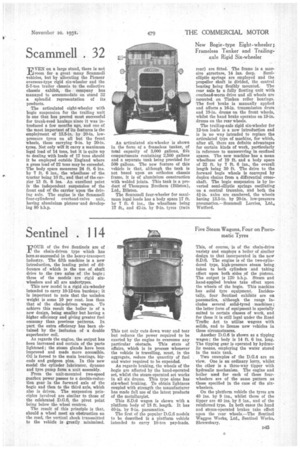Scammell . 32
Page 33

If you've noticed an error in this article please click here to report it so we can fix it.
EVEN on a large stand, there is not room for a great many Scasamell vehicles, but by allocating the Pioneer overseas-type rigid six-wheeler and the 5-7-ton trailer chassis to the collective chassis exhibit, the company has managed to accommodate on stand 32 a splendid , representation of its products.
The articulated eight-wheeler with bogie suspension for the trailing unit is one that has proved most successful for trunk-road haulage since it was introduced a few months ago, and one of the most important of its features is the emplojment of 13.5-in. by 20-in, lowpressure tyres on all but the front wheels, these carrying 9-in. by 20-in. tyres. Not only will it carry a maximum legal load of 14 tons, but it is quite up to dealing with loads of 17 tons should it be employed outside England where a gross load of 22 tons may be exceeded. The body space measures 24 ft. 6 ins. by 7 ft. 8 ins.' the wheelbase of the tractor being 10 ft., and that of the carrier 13 ft. 6 ins. An excellent point is the independent suspension of the front end of the carrier upon the driving axle. The engine is the ScammeIl four-cylindered overhead-valve unit, having aluminium pistons'and developing 80 b.h.p.
An articulated six-wheeler is shown in the form of a frameless tanker, of total capacity of 3,000 gallons, filTe compartments containing 2,500 gallons and a separate tank being provided for 500 gallons. The new feature of this vehicle is that, although the tank is not based upon an orthodox chassis frame, it is of aluminium construction with welded joints. This tank is a product of Thompson Brothers (Bilston), Ltd., Bilston.
The Searnmell four-wheeler for maximum legal loads has a body space 17 ft. by 7 ft. 6 ins., the wheelbase being 17 ft., and 42-in. by 9-in. tyres (twin rear) are fitted. The frame is a mas sive structure, 14 ins. deep. Semi. elliptic springs are employed and the propeller shaft is divided, the central bearing being flexibly mounted. The rear atte is a fully floating unit with overhead-worm drive and all wheels are mounted on Timken roller bearings. The foot brake is manually applied and affects a 16-in. transmission drum and 19-in, drums on the front wheels, whilst the hand brake operates on 19-in. drums on the rear wheels.
The trailing-axle rigid six-wheeler for 12-ton loads is a new introduction and is in no way intended to replace the articulated type of machine, for which, after all, there are definite advantages for certain kinds of work, particularly in reference to manceuvring in confined spaces. The new machine has a mean wheelbase of 19 ft. and a body space of 22 ft. by 7 ft. 6 ins., the overall length being 30 ft. The drive to the forward bogie wheels is conveyed by duplex chains from a differential crossshaft. The bogie suspension is by inverted semi-elliptic springs oscillating on a central trunnion, and both the 41-in, axles are cambered, the wheels having 13.5-in. by 20-in, low-pressure pneumatics.—Scanimell Lorries, Ltd., Watford.
















































































































































